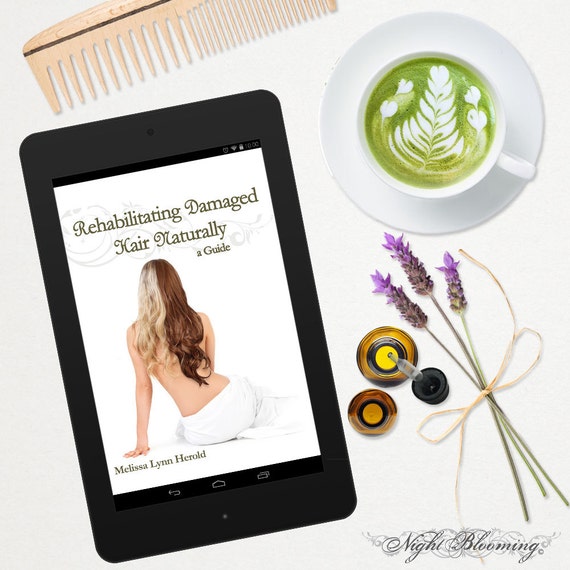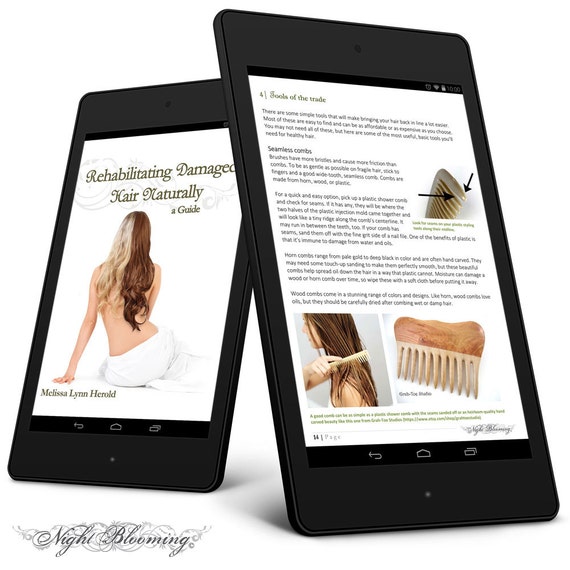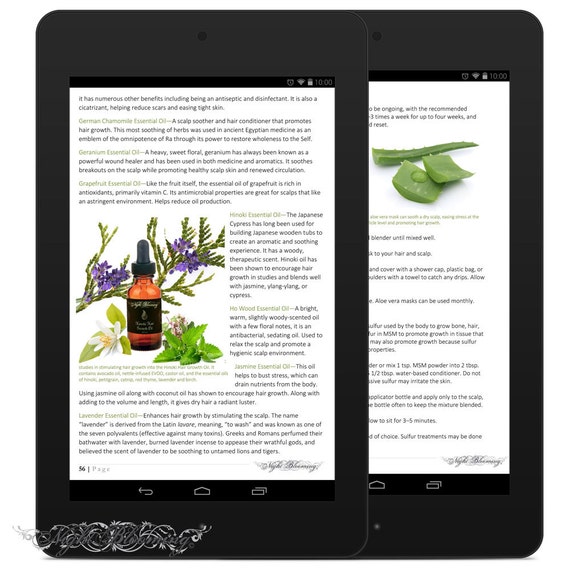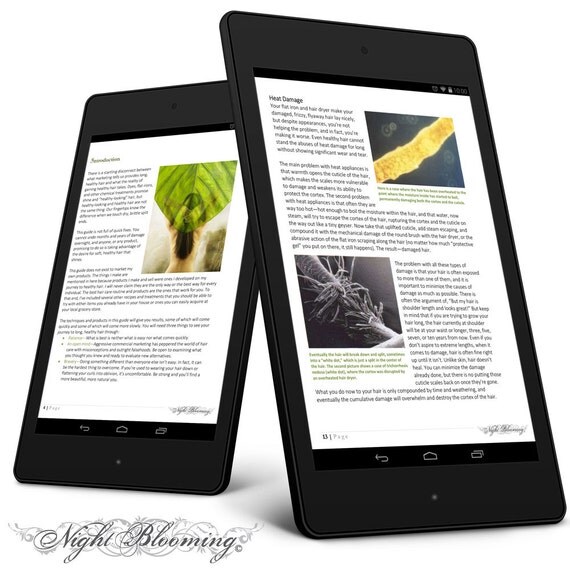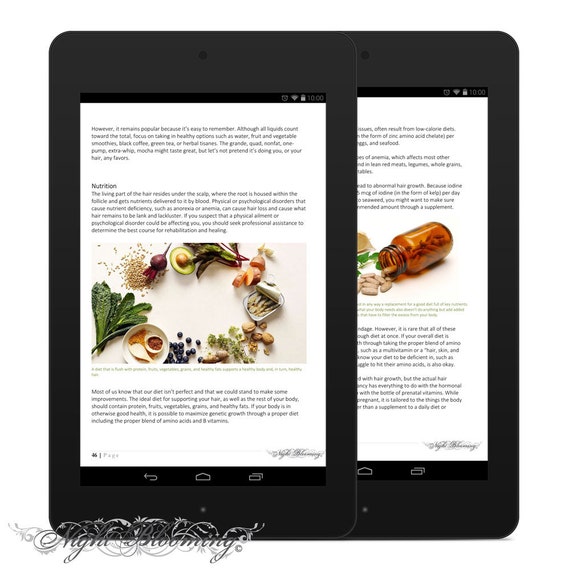First of all, let's not forget that Nightblooming had a bunch of cool reveals and giveaways to celebrate the relaunch of this book!
Go to Nightbloomings blog to take a look at it.
Nightblooming will also relaunch the Coloring Hair Naturally With Henna & Other Herbs at a later time.
Since I've been a long time liker (I don't know what else to call it. I won't say I'm a follower or admirer, but more someone who likes her works and advice!) of Nightblooming, I really hope we can find the time some day to set up an interview. I have quite a few questions I would like to ask, about what motivates her, how she got started on both the book and her Etsy store, and how she paints such awesome pictures with her product names and descriptions!
Now, on to reviewing Nightbloomings Rehabilitating Damaged Hair Naturally book...
Etsy listing for purchasing the E-book
This is an instant-download e-book in PDF, .mobi, and .epub formats. It will be delivered electronically and within minutes of your order to the email address you have associated with your Etsy account!As promised, the E-book was delivered quickly, so that was a plus right away.
My first impression of the E-book is that it's pretty, clean and with a pleasant design. Nothing crowded, tacky or glittery going on there. It has a trustworthy seriousness to the design itself.
This guide is does not exist to market my own products. The things I make are mentioned because the products I make and sell were ones I developed on my journey to healthy hair. I will never claim they are the only way or the best way for every individual. The best hair care routine and products are the ones that work for you. To that end, I’ve included several other recipes and treatments that you should be able to try with items you have in your house, or ones you can easily acquire at your local grocery store.I like that Nightblooming points this out, both in the Etsy listing and on the first page of the book itself.
Through the entire process my hair was evolving, not only into something longer, but something healthier. One day though you'll realize that your hair is starting to feel nice. And another day you'll see it's starting to shine again. Sometime from then you'll notice that the detangling comes easier and that you may be able to push that trim back a week. Treat each of these realizations as the victory that it is.
This is really good advice and it's preparing people for what might be a long haul for some.
Healthy-looking hair and healthy hair are two different things. Mainstream marketing tells us that dyes, flat irons, and chemical treatments will give us shine and length, but too many women learn that these promises get broken as easily as their own brittle hair.
Rehabilitating Damaged Hair Naturally looks to change all that. Even if your hair is dry and rife with split ends, there is a way back to health: holistic methods and natural ingredients, backed by years of testing and research. This book will help you understand what healthy hair is, how to grow it, and how to mitigate and prevent damage. With simple at-home diagnostic tests and treatments, Rehabilitating Damaged Hair Naturally will teach what your hair needs most and empower you with the confidence to customize your own haircare routine.
More than 70 pages of text, pictures, charts, diagrams, and recipes make Rehabilitating Damaged Hair Naturally both the compass and the encouraging guide that will accompany you on your journey back to healthy hair the natural way.
Table of Contents
1| How my journey began
This book is the culmination of years of research and trial and error along my own path to healthy hair. Learn how traditional hair care destroyed my hair, and how I found my way back to healthy hair following natural methods.This chapter had had me smiling and cringing, often at the same time! So relateable how Nightblooming really believed hair dyes would do what the commercials claimed and heal her hair.
It immediately reminded me of being 13 (14 maybe?) and wondering why my freshly bleached hair with the green streaks wasn't feeling as soft as it did before, when the dye box promised... Ugh, so cringe looking back at it with what I know now!
2| Understanding healthy hair
This section breaks down the structure of the hair so you better understand how its affected, for good or ill, by things you do to it.This is a brilliant chapter. Such an awesome idea to start off with the simple science and mechanics of how hair actually grows and functions. Having this background knowledge will help avoid some of the worst mistakes and haircare traps you can fall into.
Nightblooming writes in a way that makes it easy to understand, without dumbing it down.
3| Understanding types of damage
Heat, dye, chemicals, and harsh styling tools all damage hair, but they each do so in a different way. Learn about each of these types, what causes them, and how to prevent each type of damage.This kind of knowledge can be hard to translate: Even if you know the mechanics and science, it can be hard to "connect the dots" and apply this knowledge to how you avoid damage during the daily life and handling of your hair. Nightblooming offers good examples and makes it easy to understand how you can actually avoid damage.
I learned some things in this chapter, like the differences in how hair dyes work. The picture illustrations are quite scary!
Also, she talks about that annoying, persistent "100 strokes a night" myth and why it's not necessary: Another plus in my book!
4| Tools of the Trade
An overview of the basic styling tools you'll want to have to style and protect your hair.This chapter made me drool for a Grah-toe studios comb! Haha. Too bad their so pricey. Maybe I should wish for a fork for Christmas? Hmm.
I could have used a little more text about tools for putting your hair up though. I think that's as important as what you use to detangle and style your hair with. Maybe in the next version? *Hint hint, Nightblooming*
5| Coming to grips with reality and your hair type
Learn about your hair's natural state and how to work with it rather than against it.The title itself had me chuckle! Again, this is solid advice and one of my pet peeves: It seems there is this focus on how some hair types are superior than others, but I think all hair types have their beauty and their bad sides. Learning to love and support your own hair type instead of trying to force it to be something else, is the best way to make your hair beautiful.
6| Diagnostics: Finding out what your hair needs
Clarifying? Protein? Moisture? We've all heard that our hair needs these things, but what are they? And now do you know which ones your hair needs? Find out in this chapter with a few simple tests that you can do with things already in your home.This actually reminded me maybe I should perform the checks and see what my hair needs. Yep, all good. Good to try the old tests again and make sure though!
7| Damage recovery & prevention treatments
Explore different types of natural treatments for your hair, including ones that impart protein and moisture. Inside this chapter you'll find recipes and information about oils, butters, rinses, and herbal muds.Some DIY recipes and a lot of information on oils, herbs and the ingredients you will usually encounter in a product. The problem with picking an oil is that I always get really confused because all the oils sound really good and nice in the description, and all oils are good for something, so how do I pick the best one for me?
I did like the information about the herbs you can use in haircare mud though. Usually people recommend higher doses and I think it can scare some off.
8| Color
Hair color is closely tied to identity. Learn what might drive you to color, and what non-damaging color options exist.This chapter has a very interesting theory on why some people dye their hair and how hair colour is linked to your identity. I'm not entirely sure I agree with the theory, but it does add up to other theories I've heard from other people before. But no matter what, I think the colour of your hair makes a big difference to your personality. Just for myself, I really like the titian for my own haircolour because I have that "in between" colour where it's not really blonde, not really brunette and not really red. I mean, when you dedicate so much thought to it, it really matters to you...
9| Trimming
Take control of your hair by learning about self-trims, microtrimming and split end hunting. This section also gives tips about selecting a pair of hair shears and busts the myth of split end repair.A really good chapter where Nightblooming explains a lot of the silly myths and use diagrams and pictures to show how trimming makes a difference for growing healthy hair. It explains some of the techniques for cutting and trimming your hair. It has a really good, personal way of explaining it where Nightblooming talks from her own experience.
10| Growing Healthy Hair
There are a few key things that can influence the rate at which your hair grows. Learn which things you can control, which things you can’t, and how to track your monthly growth.Lead-in chapter for the following where Nightblooming goes more in detail with the things you can do to improve hair growth.
11| Lifestyle, hydration & nutrition
Feed your body and your hair with proper nutrition, hydration, and healthy choices. Discover which nutrients are most important to hair and which foods contain them, across all diets.Ah, positive lifestyle habits. Something so simple, yet so hard to get done in a busy life. The chapter covers proteins, healthy fats, vitamins, minerals and anti oxidants for a healthy body and healthy hair. It covers everything in a sensible and easy to understand way. I especially like that it dedicates a bit of the book on megadosing!
12| Topical applications
Gels, creams, oils, essential oils and other serums can be applied to the scalp with the goal of stimulating growth. This section not only provides you with recipes, but also breaks down individual ingredients and their benefits so you can customize your treatments.So much information on essential oils! I feel a bit lost at this: Everything sounds good for something, so how do you know what to pick?
It also covers monistat, something I must admit I've never understood why people will use before. Nightblooming explains this in a way where I actually understand why people use this. It makes sense now, but I still feel a bit icked out by the idea!
There is also a lot of recipes for hair masks using everyday ingredients you could find around the house.
13| Growth-stimulating techniques
Treatments such as scalp massage, the inversion method, and acupressure not only encourage growth, they also allow you to expand your knowledge about what your hair and scalp respond best to, try something new, and empower you to be an active participant in your hair growth.This chapter has "recipes" for how to do scalp massage, the inversion method, and acupressure on yourself. There are a lot of different methods on how to do these out there on the internet, but these are simple how-tos and a good place to start.
My conclusion is that this is a really nice book to have, something that any longhair should have in his or her digital bookcase. It's a no nonsense book with solid advice and personal anecdotes. It's a good reminder to stick to your simple and efficient routine and being kind to your hair. No matter how much you already know, you will learn something new one way or another.







